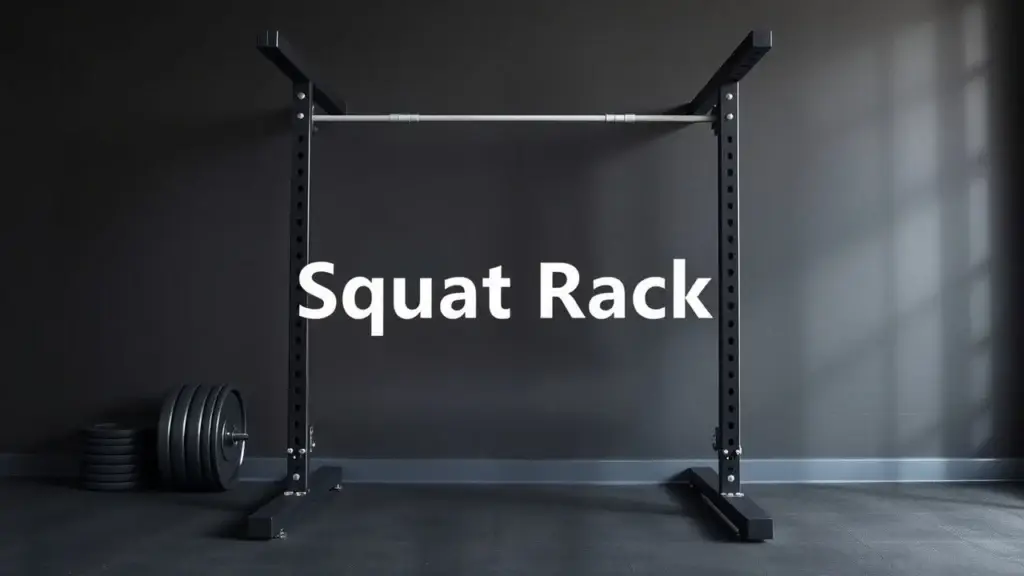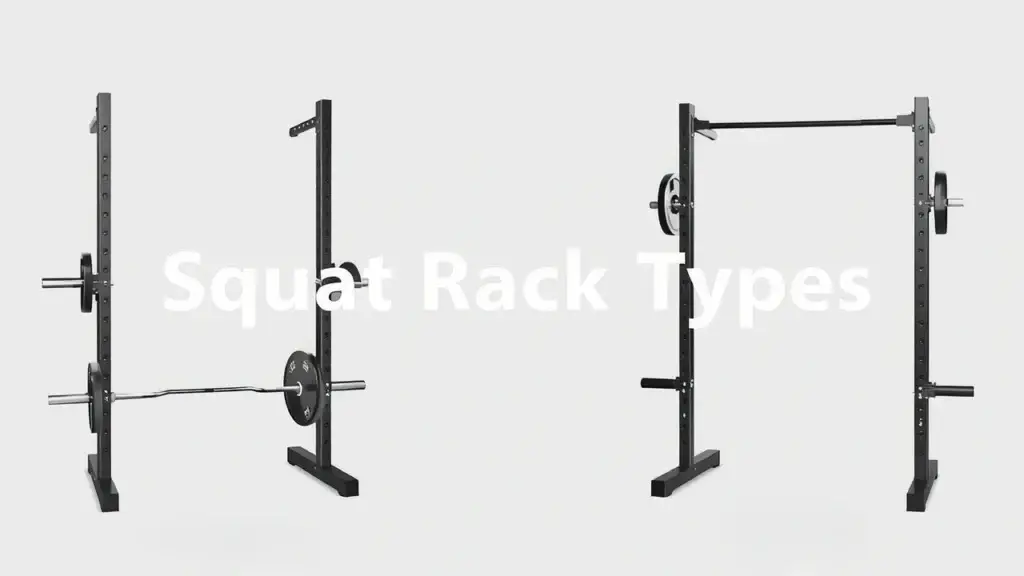Discover the different types of squat racks, including full, half, and power racks, highlighting features and a buying guide to help you choose. Find the perfect squat rack for your home gym or commercial space.
What Is a Squat Rack and Why Do You Need One?

A squat rack is super important for weightlifting. It helps you lift weights safely and correctly. When you use a squat rack, you can do exercises like squats, bench presses, and overhead lifts without worrying too much about getting hurt.
Using a squat rack makes your workouts safer. It gives you support so you can focus on your form. If you happen to lose balance while lifting heavy weights, the squat rack will catch the barbell. This way, it won’t fall on you!
Here are some types of squat racks:
- Power Rack: This has four vertical posts that create a safe space around you. It’s great for serious lifters who want to do lots of different exercises safely.
- Half Rack: This one has just two vertical posts. It takes up less space but still gives good support for squats and other lifts.
- Squat Stand: A basic option with two upright supports. It’s portable, making it perfect for home gyms where space is tight.
- Adjustable Squat Rack: You can easily change the height settings on these racks, making them useful for different exercises or heights.
- Free-standing Squat Rack: These can be put anywhere in your gym without needing to attach them to walls.
Knowing about these types helps you pick which one works best for you.
Benefits of Using a Squat Rack in Your Home Gym or Commercial Space
Adding a squat rack to your home gym setup can really boost how well you work out. It gives solid support during lifts. With its strong design, you can concentrate on getting the right form instead of worrying about balancing weights.
Squat racks aren’t just for squats; they let you do many other workouts too! You can try pull-ups and lunges if the rack has extra features like pull-up bars or dip stations. This makes them valuable in both personal spaces and commercial gyms where using equipment wisely matters.
In short, having a good squat rack helps improve safety and performance during strength training at home or in professional spaces alike.
Types of Squat Racks Explained
Power Rack vs Half Rack vs Other Types – Which One Fits Your Needs?
Power Racks
Power racks, also called full racks or Olympic squat racks, are made for serious lifters. They have adjustable safety bars and options for pull-up bars. J-cups hold the barbell securely. These heavy-duty squat racks create a safe spot for exercises like squats and bench presses.
Advanced lifters with space at home find power racks super useful. They let you do many workouts but take up a lot of room.
Here are some pros and cons:
- Pros: Great for heavy weights and many exercise options.
- Cons: They need plenty of space and can be pricey.
Half Racks
Half racks are smaller than power racks but still do the job. They usually miss some safety features that full racks have but keep things simple.
These compact squat racks work best for folks looking to save money while still getting decent functionality.
Pros include:
- Pros: Space-saving and still allow for good workouts.
- Cons: Limited safety features for heavy lifts.
Wall-Mounted Squat Racks
Wall-mounted squat racks are perfect for saving floor space since they attach right to the wall. Installing them is easy, but you must anchor them correctly in studs or concrete.
These squat stands fit well in small apartments or tight home gyms where every bit of space counts.
Some advantages and disadvantages:
- Advantages: Less floor space used and often cheaper than free-standing options.
- Disadvantages: Limited adjustability compared to other types.
Portable/Foldable Squat Stands
Portable or foldable squat stands are great if you need something temporary or easy to move around. They’re perfect for travel or quick setups.
These stands let you store your equipment easily, but they might not handle heavy weights as well as sturdier models like power or half racks.
Keep these points in mind when choosing your squat rack!
Power Racks
Features and Benefits of Power Racks
Power racks are super helpful for people who lift weights. They help keep you safe and stable while you work out. One of the best things about a power rack is the adjustable safety bars. You can set these bars at different heights. If you can’t lift the weight, they catch the barbell, which is really important for exercises like squats and bench presses.
Most power racks also have J-cups. These hold the barbell when you’re not using it, so there are fewer accidents. Some models even come with pull-up bars or extra attachments, like dip stations or landmines. This makes your workouts more exciting and varied!
When picking a power rack, check its weight capacity and quality. Many commercial-grade racks can handle heavy weights and last a long time. Popular brands include Rogue Fitness and Titan Fitness, which offer many choices for home or gym use.
Key Features
- Adjustable Safety Bars: These protect you by catching the barbell if you drop it.
- J-Cups: These safely hold barbells when not in use.
- Attachments: Extras like pull-up bars give you more workout options.
- Weight Capacity: Make sure it can handle the weights you lift; most are built for heavy loads.
With all these features, power racks are great tools for different training styles and help keep users safe.
Pros and Cons of Power Racks
Power racks have good sides and some downsides to think about:
- Versatility: You can do many exercises safely with them.
- Stability: They are built strong, so they support heavy weights well.
On the flip side:
- Space Requirements: They need a lot of floor space, which might not fit in smaller home gyms.
- Cost: They usually cost more than other types like half-racks or wall-mounted options.
Think about these pros and cons when deciding if a power rack is right for you.
Half Racks: Space-Saving Solutions
Features and Benefits of Half Racks
Half racks are great for those who want to work out but have little space. They come with upright posts that give solid support when you lift weights. You can adjust these posts to different heights. This helps you find the right position for your workouts.
J-cups are another important part of half racks. They hold the barbell in place when you are not using it. A good pair of J-cups keeps the bar secure and helps prevent accidents while lifting.
Some half racks even have pull-up bar attachments. This adds more exercises you can do, like chin-ups and muscle-ups, without needing extra equipment.
One of the best things about half racks is their compact design. They fit well in small home gyms and take up less space than full power racks. You can still do effective weightlifting workouts without crowding your area.
Pros and Cons of Half Racks
When comparing half racks to other options like power racks, a big plus is their price. Half racks are usually cheaper than full-sized ones but still give you essential features for strength training.
Safety is another important topic. Many half racks have safety bars that catch a falling barbell if you fail a lift. However, they might not be as safe as bigger power racks because they have fewer supports around you.
Half racks work best in home gym setups with limited space or for lighter training routines. They help beginners and intermediate lifters do squats and bench presses safely without taking too much room in your garage or basement gym setup.
| Feature | Half Rack | Power Rack |
|---|---|---|
| Space Efficiency | Compact design | Larger footprint |
| Affordability | Generally more affordable | Higher price point |
| Safety Features | Safety bars available | More extensive safety options |
| Versatility | Can include pull-up bars | Often includes multiple attachments |
Overall, half racks are a smart choice for anyone wanting to build strength in a small area while keeping costs down.
Wall-Mounted Racks: Maximizing Space
Features and Benefits of Wall-Mounted Racks
Wall-mounted squat racks are a great choice if you’re tight on space. These racks stick right to the wall, so they don’t take up any room on the floor. This makes them perfect for smaller home gyms or apartments.
To install a wall-mounted rack, you need to make sure it’s attached to wall studs. This keeps it safe when you lift heavy weights. Most kits come with everything you need, like brackets and bolts. So, as long as you have some basic tools, you can set it up easily.
One big plus of these space-saving squat racks is that they help clear out your workout area. Many racks let you adjust their height to fit your needs, giving you flexibility without needing extra space.
Pros and Cons of Wall-Mounted Racks
There are some cool advantages of wall-mounted racks. First off, they use less space than big freestanding models. They’re usually cheaper too since they require fewer materials to make. Plus, they give you a stable spot for doing squats and other exercises without crowding your gym area.
On the flip side, there are some downsides. Installing these racks can be tricky, and if you don’t do it right, it can be unsafe when working out. Also, many wall-mounted options don’t let you adjust them much after setup because they’re fixed in place.
These squat racks work well in small apartments or compact home gyms where every square foot counts. They’re great for folks who mainly do bodyweight exercises or lift lighter weights but might not be the best for those needing extra features like pull-up bars or multiple attachments found in bigger setups.
| Feature | Advantages | Disadvantages |
|---|---|---|
| Space Efficiency | Saves floor area | Limited adjustability |
| Affordability | Generally lower cost | Installation challenges |
| Ideal Use Cases | Great for small spaces | May not support heavy lifting |
Wall-mounted squat racks provide an excellent option for anyone looking to include strength training in tight spaces while keeping costs low. Just remember to weigh the benefits against the limits before deciding!
Portable Squat Racks: Flexibility and Mobility
Features and Benefits of Portable Racks
Portable squat racks are great for people who need to work out anywhere. They often have a foldable design, which makes it super easy to pack them up and take them along. This feature helps those with small spaces at home or those who travel a lot.
The materials used in making these racks are smart choices. Many portable squat racks use lightweight metals that are strong enough to handle heavy weights. For example, aluminum is popular because it’s light but still tough during lifts.
Another cool thing about portable racks is how easy they are to move. You can set up a gym anywhere you want—like at a friend’s house, in a park, or even when you’re on vacation. This flexibility makes it easier to keep up your workout routine no matter where you are.
Pros and Cons of Portable Racks
When thinking about portable squat racks, it’s important to look at the good and the bad. On the plus side, these racks are super portable; they’re simple to move and store compared to heavier models. But this ease of use can come with less stability. While some have features like rubber feet or wider bases for better balance, they might not be as sturdy as fixed racks.
Weight capacity is another point to think about when looking at portable options versus fixed ones. Many portable squat racks can hold less weight because they focus on being light and easy to transport. Beginners may find these limits okay at first, but they should think ahead if they plan on lifting heavier weights down the line.
Good times to use portable squat racks include when space is tight or when you need to train in different places—like outside workouts or shared gym areas where equipment needs to be moved often.
Choosing the Right Squat Rack: A Buyer’s Guide

Key Factors to Consider
When picking a squat rack, think about some important factors. Start with your budget. Prices can be really different based on the type and features of the rack. Next, check how much space you have. Some racks are smaller and fit better in tight spots.
Your experience level matters too. If you’re new to working out, an adjustable squat rack can be a good choice. It gives you flexibility without making things too hard. Also, ask yourself about your training goals. Are you into powerlifting or bodybuilding? Make sure your rack can help you with those aims.
Don’t forget to consider what exercises you want to do most often. Squats are just one part of it! Also, look closely at the weight capacity of different racks. You need one that can handle your lifting safely.
Matching Needs to Rack Type
Finding the right type of squat rack is key for getting the best workouts. Here are some options:
- A half-rack is great if you’re short on space but still want to do squats and bench presses.
- A full power cage offers more safety features and lets you do a lot more exercises.
Using a simple decision tree can make your choice easier. This tool helps you compare things like size and features based on what you like and how you work out.
Additional Considerations
Think about more than just cost and function when choosing a squat rack. The build quality is very important. Look for brands known for their toughness so they last longer without needing repairs.
Safety features should not be ignored either! Check for things like adjustable spotter arms or safety pins to help prevent accidents while lifting heavy weights.
Don’t skip on warranty details! Go for companies that offer solid guarantees on their products.
If you’re into making things your own, check out DIY options online. They can help you create a rack that fits your specific needs while possibly saving some cash compared to buying a brand-new one.
Now that you’re ready to choose the right squat rack, remember these tips to help make your workouts safe and effective!
Safety, Maintenance, and Best Practices
Safety First
When using a squat rack, safety should always be your top priority. Here are some important tips for safe workouts:
- Maintain Proper Form: Always focus on your form when doing exercises. Bad form can cause injuries. Make sure you know how to do squats and other lifts correctly.
- Use Spotters: If you’re lifting heavy weights, it’s really helpful to have a spotter. A spotter can help if you struggle with the weight or lose balance.
- Understand Weight Limits: Every squat rack has specific weight limits based on its design and materials. Don’t exceed these limits, as it could cause equipment failure or injuries.
Following these tips creates a safer workout space and reduces risks when strength training.
Maintenance and Care
To keep your squat rack in good shape, regular maintenance is key:
- Inspect Regularly: Check your squat rack often for signs of wear or damage, like rust or loose bolts.
- Clean Equipment: Wipe down surfaces after each use to prevent rusting or corrosion from sweat and moisture.
- Lubricate Moving Parts: If your squat rack has adjustable parts like J-cups or safety bars, lubricate them as needed for smooth operation.
Taking care of your squat rack helps it last longer and works better during workouts.
Proper Setup and Adjustment
Setting up your squat rack right is important for safety and effectiveness:
- Safety Bars Setup Instructions:
- Place the safety bars at the right height so they catch the barbell if you fail a lift.
- Make sure they are locked in place before starting any exercise.
- Adjusting J-Cups:
- Adjust J-cups according to your height for easy access when loading weights.
- Ensure they are securely fastened after adjusting to avoid accidents during lifts.
Following these steps helps keep proper form while ensuring safety during workouts.
FAQs about Types of Squat Racks
What types of squat racks are available?
Squat racks come in many types, including power racks, half racks, and wall-mounted racks. You can also find portable and adjustable options.
What should I consider for squat rack safety?
Choose a rack with safety features like spotter arms or safety straps. Always check the weight limits before lifting.
How do I install a squat rack?
Installation involves securing the rack to the floor or wall. Use proper mounting hardware for stability. Follow the manufacturer’s instructions carefully.
Are there squat racks designed for small spaces?
Yes, compact and foldable squat racks save space. Wall-mounted options are also excellent for tight areas.
What are some recommended squat rack accessories?
Consider adding dip bars, pull-up bars, or weight plate storage. Attachments like landmines or cable systems enhance versatility.
How much weight can different types of squat racks hold?
Weight capacity varies by type and brand. Commercial-grade racks usually support heavier weights than home models.
Can I build my own squat rack?
Yes, DIY squat racks are popular. You can customize them to fit your needs and save costs on equipment.
Additional Insights on Squat Racks
- Powerlifting Squat Rack: Designed for serious lifters with specific features.
- Heavy-Duty Squat Rack: Built for maximum stability and weight capacity.
- Lightweight Squat Rack: Easy to move but may have lower weight limits.
- Folding Squat Racks: Great for small spaces; they fold away when not in use.
- Squat Cage: Provides a fully enclosed area for safer lifts.
- Multi-Functional Rack: Offers various exercises beyond squats, enhancing workout diversity.
- Safety Squat Rack: Features added safety mechanisms for heavy lifting.
- Squat Rack Installation Tips: Securely anchor it to prevent movement during workouts.
- Popular Brands: Rogue Fitness and Titan Fitness are known for quality squat racks.
- Squat Rack Maintenance: Regular inspections help maintain safety and performance.
These points cover various aspects of squat racks that could guide your selection process and usage effectively.
Related Topics
- Types of Power Racks
- Types of Half Racks
- Types of Wall-Mounted Squat Racks
- Types of Portable Squat Racks
- Types of Squat Rack Accessories
- Types of Squat Rack Brands



Types of Squat Racks: A Complete Guide for Home Gyms and More